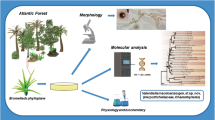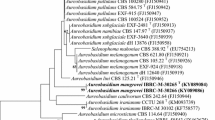Abstract
Ten strains of a new endophytic ascospore-forming, methanol-assimilating yeast were isolated from the galls induced by sawflies on the leaves of willows in the Losiny Ostrov National Park (Moscow region). Standard phenotypical tests and phylogenetic analyses of 18S rRNA gene, 5.8S-ITS gene region and 26S rRNA gene (D1/D2 domains) sequences showed that the species belongs to the genus Ogataea. We describe it as Ogataea cecidiorum and designate type culture KBP Y-3846 (= CBS 11522T = VKM Y-2982T = VKPM Y-3482T = MUCL 52544T = NCAIM Y.01965T) as the type strain. The new species was registered in MycoBank under MB 515233.


Similar content being viewed by others
References
Esteve-Zarzoso B, Belloch F, Uruburu A, Querol A (1999) Identification of yeasts by RFLP analysis of the 5.8S rRNA gene and the two ribosomal internal transcribed spacers. Int J Syst Evol Microbiol 49:329–337
Fall R, Benson A (1996) Leaf methanol—the simplest natural product from plants. Trends Plant Sci 1:296–301
Felsenstein J (1985) Confidence limits on phylogenies: an approach using the bootstrap. Evolution 39:783–791
Fidalgo-Jiménez A, Daniel H-M, Evrard P, Decock C, Marc-André Lachance M-A (2008) Metschnikowia cubensis sp. nov., a yeast species isolated from flowers in Cuba. Int J Syst Evol Microbiol 58:2955–2961
Glushakova AM, Yurkov AM, Chernov IYu (2007) Massive isolation of anamorphous ascomycete yeasts Candida oleophila from plant phyllosphere. Microbiology 76(6):799–803
Hinzelin F, Kurtzman CP, Smith MTh (1991) Williopsbs salicorniae sp. nov. Antonie van Leeuwenhoek 59:125–127
Inácio J, Rodrigues MG, Sobral P, Fonseca Á (2004) Characterisation and classification of phylloplane yeasts from Portugal related to the genus Taphrina and description of five novel Lalaria species. FEMS Yeast Res 4:541–555
Isaeva OV, Glushakova AM, Yurkov AM, Chernov IYu (2009) The yeast Candida railenensis in the fruits of English oak (Quercus robur L.). Microbiology 78(3):355–359
James SA, Roberts IN, Collins MD (1998) Phylogenetic heterogeneity of the genus Williopsis as revealed by 18s rRNA gene sequences. Int J Syst Bacteriol 48:591–596
Kachalkin AV, Glushakova AM, Yurkov AM, Chernov IYu (2008) Characterization of yeast groupings in the phyllosphere of Sphagnum mosses. Microbiology 77(4):474–481
Kato K, Kurimura Y, Makiguchi N, Asai Y (1974) Determination of methanol strongly assimilating yeasts. J Gen Appl Microbiol 20:123–127
Katoh K, Misawa K, Kuma K, Miyata T (2002) MAFFT: a novel method for rapid multiple sequence alignment based on fast Fourier transform (describes the FFT-NS-1, FFT-NS-2 and FFT-NS-i strategies). Nucleic Acids Res 30:3059–3066
Kishino H, Hasegawa M (1989) Evaluation of the maximum likelihood estimate of the evolutionary tree topologies from DNA sequence data, and the branching order in hominoidea. J Mol Evol 29:170–179
Kurtzman C (1992) DNA relatedness among phenotypically similar species of Pichia. Mycologia 84:72–76
Kurtzman CP, Fell JW (1998) Yeasts, a taxonomic study, 4th edn. Elsevier, Amsterdam
Kurtzman C, Robnett C (1998) Identification and phylogeny of ascomycetous yeasts from analysis of nuclear large subunit (26S) ribosomal DNA partial sequences. Antonie van Leeuwenhoek 73:331–371
Kurtzman C, Robnett C (2010) Systematics of methanol assimilating yeasts and neighboring taxa from multigene sequence analysis and the proposal of Peterozyma gen. nov., a new member of the Saccharomycetales. FEMS Yeast Res. doi:10.1111/j.1567-1364.2010.00625.x
Kurtzman C, Robnett C, Basehoar-Powers E (2008) Phylogenetic relationships among species of Pichia, Issatchenkia and Williopsis determined from multigene sequence analysis, and the proposal of Barnettozyma gen. nov., Lindnera gen. nov. and Wickerhamomyces gen. nov. FEMS Yeast Res 8:939–954
Lee JD, Komagata K (1980) Pichia cellobiosa, Candida cariosilignicola, and Candida succiphila, new species of methanol-assimilating yeasts. Int J Syst Bacteriol 30:514–519. doi:10.1099/00207713-30-2-514
Limtong S, Srisuk N, Yongmanitchai W, Yurimoto H, Nakase T (2008) Ogataea chonburiensis sp. nov. and Ogataea nakhonphanomensis sp. nov., thermotolerant, methylotrophic yeast species isolated in Thailand, and transfer of Pichia siamensis and Pichia thermomethanolica to the genus Ogataea. Int J Syst Evol Microbiol 58:302–307
Morais R, Teixeira L, Bowles J, Lachance M-A, Rosa C (2004) Ogataea falcaomoraisii sp. nov., a sporogenous methylotrophic yeast from tree exudates. FEMS Yeast Res 5:81–85
Nagatsuka Y, Saito S, Sugiyama J (2008) Ogataea neopini sp. nov. and O. corticis sp. nov., with the emendation of the ascomycete yeast genus Ogataea, and transfer of Pichia zsoltii, P. dorogensis, and P. trehaloabstinens to it. J Gen Appl Microbiol 54:353–365
Naumova ES, Gazdiev DO, Naumov GI (2004) Molecular divergence of the soil yeasts Williopsis sensu stricto. Microbiology 73(6):768–776
Péter G, Tornai-Lehoczki J, Fulop L, Dlauchy D (2003) Six new methanol assimilating yeast species from wood material. Antonie van Leeuwenhoek 84:147–159
Péter G, Dlauchy D, Tornai-Lehoczki J (2006) Candida floccosa sp. nov., a novel methanol-assimilating yeast species. Int J Syst Evol Microbiol 56:2015–2018
Péter G, Tornai-Lehoczki J, Dlauchy D (2007) Ogataea allantospora sp. nov., an ascomycetous yeast species from phylloplane. Antonie van Leeuwenhoek 92:443–448
Péter G, Tornai-Lehoczki J, Dlauchy D (2008) Ogataea nitratoaversa sp. nov., a methylotrophic yeast species from temperate forest habitats. Antonie van Leeuwenhoek 94:217–222
Phaff HJ, Miller MW, Spencer JFT (1964) Two new species of Pichia isolated from slime fluxes of deciduous trees. Antonie van Leeuwenhoek 30:132–140
Posada D, Crandall K (1998) Modeltest: testing the model of DNA substitution. Bioinformatics 14(9):817–818
Price PW (2005) Adaptive radiation of gall-inducing insects. Basic Appl Ecol 6:413–421
Redfern M, Shirley P (2002) British plant galls: identification of galls on plants and fungi. Field Stud 10:207–531
Sampaio J, Gadanho M, Santos S, Duarte F, Pais C, Fonseca A, Fell J (2001) Polyphasic taxonomy of the basidiomycetous yeast genus Rhodosporidium: Rhodosporidium kratochvilovae and related anamorphic species. Int J Syst Evol Microbiol 51:687–697
Stamatakis A, Hoover P, Rougemont J (2008) A rapid bootstrap algorithm for the RAxML web-servers. Syst Biol 75(5):758–771
Suh S, Blackwell M, Kurtzman C, Lachance M (2006) Phylogenetics of Saccharomycetales, the ascomycete yeasts. Mycologia 98:1006–1017
Suzuki M, Nakase T (1999) A phylogenetic study of ubiquinone Q-8 species of the genera Candida, Pichia, and Citeromyces based on 18S ribosomal DNA sequence divergence. J Gen Appl Microbiol 45:239–246
Swofford DL (2002) PAUP: phylogenetic analysis using parsimony, version 4.0b10. Illinois Natural History Survey, Champaign
Van der Walt JP, Yarrow D (1984) Methods for the isolation, maintenance, classification and identification of yeasts. In: Kreger-van Rij NJW (ed) The yeasts. A taxonomic study, 3rd edn. Elsevier, Amsterdam, pp 45–105
Villa-Carvajal M, Querol A, Belloch C (2006) Identification of species in the genus Pichia by restriction of the internal transcribed spacers (ITS1 and ITS2) and the 5.8S ribosomal DNA gene. Antonie van Leeuwenhoek 90:171–181
White TJ, Bruns T, Lee S, Taylor JW (1990) Amplification and direct sequencing of fungal ribosomal RNA genes for phylogenetics. In: Innis M et al (eds) PCR protocols: a guide to methods and applications. Academic Press, Orlando, pp 315–322
Yarrow D (1998) Methods for the isolation, maintenance and identification of yeasts. In: Kurtzman CP, Fell JW (eds) The yeasts. A taxonomic study, 4th edn. Elsevier, Amsterdam, pp 77–100
Yurkov AM, Chernov IYu (2005) Geographical races of certain species of ascomycetous yeasts in the Moscow and Novosibirsk regions. Microbiology 74(5):597–601
Acknowledgements
The authors are grateful to Chernov, I.Yu. (Moscow State University, Russia) and Daniel, H.-M. (BCCM/MUCL, Belgium) for their valuable suggestions on the manuscript. We also thank Prokhorov, V. P. (Moscow State University, Russia) for correcting the Latin diagnosis of the novel species. Schäfer, A. M. and Maier, W. (Ruhr-Universität Bochum, Germany) are acknowledged for various assistance. This work was supported by the Russian Foundation for Basic Research, project no. 07-04-00481, and the Russian Federation President’s Program to support the Russian Ph.D. research scientists, project no. MK-5278.2008.4. Andrey Yurkov holds a Post-doc fellowship (A/07/94549) from German Academic Exchange Service (DAAD, Germany). We thank Kurtzman C.P. and Robnett C.J. for sharing unpublished data and suggestions to the manuscript. The type strains of Ogataea nitratoaversa and Pichia trehalophila were kindly provided by Péter G (NCAIM, Hungary) and Daniel H.-M. (BCCM/MUCL, Belgium).
Author information
Authors and Affiliations
Corresponding author
Electronic supplementary material
Below is the link to the electronic supplementary material.
Fig. S1
PCR fingerprinting profiles with primer M13 for selected strains of O. cecidiorum sp. nov. Lanes: M, markers; N, negative control; 1, ex type of O. cecidiorum; other analysed strains of O. cecidiorum: 2, iG-P2; 3, iG-P3; 4, iG-P4; 5, iG-P5; 6, iG-P6; 7, iG-P7; 8, iG-P8; 9, iG-P9; 10, iG-10. Strains conspecific according to 5.8S-ITS sequence data are marked with asterisk. (TIFF 478 kb)
Fig. S2
Phylogenetic placement of O. cecidiorum obtained by maximum likelihood analysis of 18S rRNA and 26S rRNA (D1/D2 domains) genes. The numbers given on branches are frequencies (>50%) with which a given branch appeared in 1,000 bootstrap replications. The scale indicates the number of expected substitutions accumulated per site. The tree is rooted with Schizosaccharomyces pombe (EU011742 U40085). Sequence accession numbers of type strains are listed, sequences determined in this study are given in bold. (EPS 512 kb)
Rights and permissions
About this article
Cite this article
Glushakova, A.M., Maximova, I.A., Kachalkin, A.V. et al. Ogataea cecidiorum sp. nov., a methanol-assimilating yeast isolated from galls on willow leaves. Antonie van Leeuwenhoek 98, 93–101 (2010). https://doi.org/10.1007/s10482-010-9433-5
Received:
Accepted:
Published:
Issue Date:
DOI: https://doi.org/10.1007/s10482-010-9433-5




